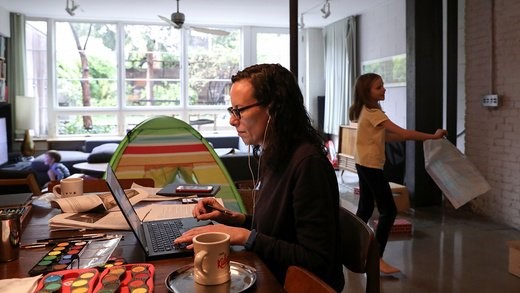The coronavirus pandemic has dramatically altered the workplace. To slow the virus’s spread and protect employees, many companies have shifted to remote work, with video calls and instant messaging replacing meetings and break room conversations. Some, including several Silicon Valley giants, have announced that they will allow employees to work from home permanently. Yet huge swathes of the labor force are unable to work remotely, and experts say these developments could have profound implications for the economy, inequality, and the future of big cities.
How has the pandemic changed how Americans work?
The number of Americans working remotely has increased dramatically since March, according to Gallup poll data. By late April, more than half of all workers, accounting for more than two-thirds of all U.S. economic activity, said they were working from home full-time. According to Nicholas Bloom, an economist at Stanford University who has studied remote work, only 26 percent of the U.S. labor force continues to work from their job’s premises.
Moreover, only a quarter of those working from home said they would voluntarily return to their office if it reopened; another quarter said they would rather work from home due to concerns about the coronavirus, while half said they wanted to continue working remotely because they prefer it.
Companies are taking note: Facebook announced that it would allow as many as half of its nearly fifty thousand employees to work from home permanently, following some smaller tech firms such as Twitter. Other industries are considering similar changes; the insurance giant Nationwide announced it would adopt a hybrid model, maintaining offices in four locations with remote work elsewhere.
What about other countries?
Researchers at the Massachusetts Institute of Technology (MIT) compared the ease of transitioning to remote work in thirty countries, including the United States. Developed countries with higher levels of internet access, a mix of occupations, and pro-worker policies naturally fared the best; these include Belgium, Canada, and Sweden. The United States, which has only average internet penetration and a higher proportion of workers who need physical proximity to other people to do their jobs, ranked eleventh. Developing and middle-income countries such as Brazil, China, and Nigeria face the most obstacles, including low internet quality and large, intergenerational families that can make it challenging to work at home.
What’s the economic impact?
It’s mixed. Remote work has been shown to increase worker productivity, but it can lead to isolation and stress as the line between work and home blurs. There are also concerns that the lack of serendipitous encounters with coworkers could stifle creativity and reduce team cohesion. School closures, meanwhile, have placed an extra burden on working parents.
Stanford’s Bloom says the shift could lead to worsening inequality as educated, high-earning workers are far more likely to be able to work remotely and thus continue to advance their careers. For the nearly half of Americans who were working in jobs such as retail, health care, transport, or other customer-facing services, prospects are grimmer.
At a CFR virtual meeting on the future of work in May 2020, Jody Miller, cofounder and co-CEO of the Business Talent Group, predicted that the widespread adoption of remote work would create a “much more real global talent marketplace,” particularly for white-collar workers. While physical proximity was an important factor in the past, “Now you really are able to imagine hiring someone who is not going to be on site very often,” she said.
What could be the effect on cities?
Some experts, including Bloom, posit that the pandemic will lead to the decline of big city centers as companies move away from dense office spaces. The shift to remote work in the tech industry in particular could see an exodus from high-cost regions such as the San Francisco Bay Area. This could add further strain to city budgets, some of which rely heavily on tax revenue from commuters and commercial real estate.
Others say reports of the death of cities are greatly exaggerated, noting that previous predictions of urban flight have not come to pass. High population density also does not guarantee high infection rates; megacities including Hong Kong, Seoul, Singapore, and Tokyo were able to contain their outbreaks much better than New York, for instance.
CFR senior fellow Edward Alden says that an outflow from major metropolises, which contain most of the country’s economic activity, could be beneficial. “This may be a way to spread the benefits of the new economy more widely on a geographical basis,” he says.
Original post https://alertarticles.info
